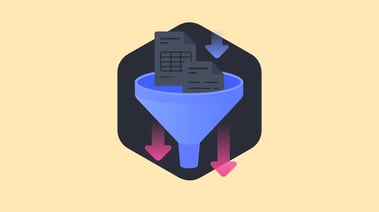With innovation, it’s important to know which process to use to develop each idea.
A lot of businesses treat innovation as a mystical set of creative activities, and use different processes and frameworks for each different project. Even worse, some businesses even make up completely new processes each time they start a new innovation project!
In this post, I’ll show you how to create the right innovation process for your projects based on our experience at Braineet.
In reality, innovation is a discipline. Like any other discipline, it can be practiced and perfected over time by using established tools, frameworks, and methods, no matter which industry you’re in.
Whether you’re talking about lean startup methods, agile development, or design thinking, you need to know which innovation processes are right for your particular project. Then, you need to know how to use these processes to guide the efforts of you and your team.
Knowing which framework is right for you will help you to get the most out of your valuable ideas. With the right methodology, you and your team will be able to do your best work every time, getting great products and services to the market faster.
In this article, we’ll guide you through the confusing question of which innovation processes are right for your project. We’ll show you how to use frameworks to structure your innovation, and how to guide your thinking with helpful tools and systems.
With our help, you’ll know how - and when! - to use different frameworks and processes, and what you need to do to get all the way from a blank page to a finished product.
Why the right process can make all the difference
If you’re reading this, you might be impatient to get started. You might even decide you can just jump into your project right away, without defining a clear process to develop your ideas.
We get it: you’re enthusiastic. And that’s great!

You might be impatient to get started, but trust us: take a second to plan your innovation first.
But trust us: designing and successfully implementing a process is no small task. When it is done well, the rewards are significant: faster to market by about 30%, higher success rates, and more projects on time & on target.
As many of the top innovation writers have noted, having world-changing ideas isn’t enough for a successful project. You also need to be deliberate about how you innovate.
Knowing about the pros and cons of the different innovation methods out there will help you and your team to get better results, and will help you work towards successful innovation.
Here are some of the benefits to selecting the right innovation process at the outset.
More certainty over what to expect
Choosing the right process makes innovation management a lot easier.
With the right process and frameworks in place, your innovation projects will run a lot more smoothly. Even better, your people won’t have to deal with as much ambiguity.
If your thinkers know what to expect, they won’t spend as much time dealing with project administration and management, and they’ll have more time to do their most innovative work.
For example, if you take the time at the start of the project to plan out a series of design sprints, including the timing, task allocation, and expected milestones, your team will know exactly what to expect from the process.
This way, you’ll be able to identify when something has gone wrong, or where you need to boost your efforts in certain areas to stay on track.
Faster development of new products
Having the right processes in place makes decision making a lot simpler and faster. After all, a confused or disorganised innovation process not only stresses people out - it also slows down the product development cycle.
Instead, by taking the time to consider and choose an innovation process, you can boost the speed and efficiency of your product development.
This isn’t just great for your new product lines: having exciting new customer offerings helps to drum up new business, and can generate excitement about your existing products, too.
Putting the right people to work
One of the hardest things when managing exciting new ideas? Knowing how to structure your innovation team.
As any manager will tell you, you can have the most creatively talented and driven people on the planet, but if you’re using a confusing or disjointed innovation process, they won’t be able to do their best work.
When businesses don’t commit to a formal innovation process, innovation projects tend to be assigned to whoever has spare time, or whoever comes to mind first. While you might kick some goals using a system like this, you won’t use your people to their full potential.
Instead, choosing the right innovation process will help you to be more systematic about assigning tasks. This way, you can put the right thinkers in the right roles, and will make sure you draw on their talents and expertise at the right time.
With the right process, your innovators will know exactly what they need to do, and the milestones they need to hit. Even better, your project managers will know they’ve got the right people doing the right work. Win-win for everyone!
Greater productivity and output
The right process can help you develop innovative ideas a lot faster, helping to drive your productivity and output.
In innovation, knowing how to select the right ideas is key. Having an established process in place will help you to be able to choose the right ideas and channel your efforts into the areas with the greatest yield for your business.
Your innovation program will start to get better results if you develop a working knowledge of the different methods and know how to use them. For example, if you develop a familiarity with agile methodology and design thinking, you’ll know when - and how - to use these processes.
This isn’t just a great way to improve the output of your existing business units - it’s also an excellent way to boost your overall ideation.
Access to a broader range of innovative new ideas
Finally, knowing when to use different innovation processes can also unlock access to a broader range of ideas, no matter which type of innovation you’re focusing on.
Whether you’re talking about open innovation, traditional R&D, or even co-creation alongside your fans and customers, idea generation is a lot easier once you have the right process to guide your thinking.

The right innovation process can unlock great new ideas.
Remember, innovation isn’t some mystical art. The process of innovation can be studied as systematically as any other process, and having a good grip on the options available can help you and your team to be more happy, productive, and successful.
With the right innovation process, you can start to prioritize your most innovative ideas, and can make sure you have the right resources in place to take advantage of these ideas sooner.
Choosing an innovation process: key factors to consider
Before you choose an innovation process to guide your project, there are a few key factors you need to consider.
It might seem like a lot of work to do before you even put pen to paper, but being clear on what you need and expect from the innovation process will help you save time and effort, and will make sure you emerge with the best possible result at the end of the line.
As innovation writers Nathan Furr and Jeff Dyer have identified, successful innovation is a matter of choosing the right process at the right time.
This comes down to two key questions:
- How developed is the idea?
- What kind of opportunity is this?
Let’s take a deeper look at what we mean by this, exactly.
Question #1) How developed is the idea?
The first thing to consider when choosing an innovation process to help develop an idea is the stage of development.
How far along in the thought process are you? Have you worked out how to turn an idea into a viable prototype? Have you figured out whether there is room in the market? And if so, have you sought input and feedback from customers and users?
Before you can test whether a product is feasible for release, you’ll need to consider whether it is desirable for potential consumers.
Developing an innovation idea might seem like a linear progression from brainstorm to product release. However, this isn’t always the case.
Even if you’re testing a developed idea for market viability, you might still need to take a step back and look at whether there is an appetite for the product. In this case, idea development is more of a spiral than a circle. Sometimes, it might take several iterations before you get it right.
Figuring out how much more work your particular idea needs will help determine which innovation process is right for you.
For example, if you’ve already got a working prototype of a particular product, you won’t need to start with basic design thinking - unless there are major flaws in the prototype. Instead, you can use agile methodologies to bring the product closer to market release.
We’ll cover this in greater detail as we describe the different innovation processes, but for now it’s something you’ll need to keep in mind.
Question #2) What kind of opportunity is this?
Second, you’ll need to determine what kind of opportunity the idea represents.
Is the idea an opportunity to identify a problem? Is it a way to define a new solution, or to take advantage of an area of ongoing growth? Or is it the kind of idea which has the potential to transform your entire business, or even give rise to an entirely new market?
Being clear about the nature of the opportunity will help determine which innovation process is right for you. Answering this question nice and early will save you a lot of time in the long run.
For example, let’s say the idea is an opportunity to solve a defined problem faced by your customers, such as delays in software updates. In this case, design thinking will help you to develop a solution, establish whether it is viable, and work towards a functional prototype.
On the other hand, if the idea is a way to develop a new market for an existing product or service (for example, Canon’s decision to market in-home printers and scanners), then agile methodologies will be a more appropriate way to organize and structure the project.
For innovation thinkers, knowing what kind of opportunity an idea represents can unlock huge benefits, and can help speed up the innovation process and solve problems. For example, writers Nathan Furr and Jeff Dyer have broken down the innovation process like this in Braineet Workflow:

Nathan Furr and Jeff Dyer’s helpful breakdown of innovation processes. Source: HBR
Now, let’s take a look at our six innovation processes you can use to structure and guide your company’s creativity:
- Design thinking
- Lean startup model
- Design sprints
- Business model innovation
- Agile methodology
- Growth & scaling
To kick things off, we’ll take a look at a fundamental technique: design thinking.
Innovation process #1: Design thinking
If you’re starting with an idea in its very earliest stages, then design thinking is a great way to get things off the ground.
Put simply, design thinking is an innovation process with a human-centered core.
Design thinking encourages organizations and businesses of all kinds to focus on human experience above all else, and to build this focus into all steps of the product development cycle. Using design thinking, innovators can empathize, focusing on customer needs.
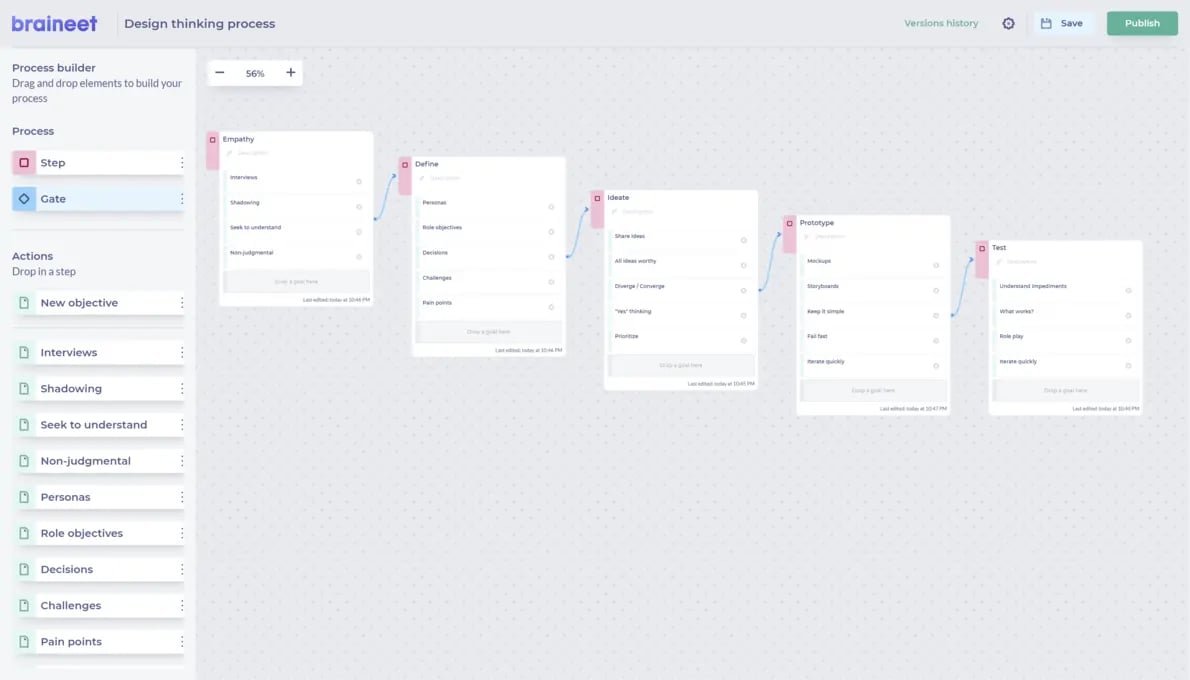
The design thinking process starts with customer empathy. Source: Dribbble
Design thinking is a great way to identify and test ideas in their early stages of development, and can be used to establish how helpful a new product or service is likely to be.
As the simple diagram above demonstrates, the typical design thinking process looks like this. To help break it down, we’ve included some typical milestones in brackets.
- Empathize: What do your users and customers experience when interacting with your existing products? What would be their ideal experience? (Milestone: Customer experience report)
- Define: Based on this customer experience, how do you define the idea or business opportunity? How does this definition change as you gather more customer experience? (Milestone: Opportunity description)
- Ideate: What are some of the ways you could ‘solve’ this problem and provide an even greater customer experience? What are the limitations and constraints for these ideas? (Milestone: Detailed innovation proposals)
- Prototype: Now that you’ve got a range of innovation proposals, how can you turn these into working prototypes? Who do you need to involve, and what kinds of experience do you need? (Milestone: Working prototype(s))
- Test: How can you test these prototypes to determine which is best? What kinds of customers / users should be involved? (Milestone: Validated project report)
Using design thinking doesn’t just help you to find new innovations, either - it can also help you discover entirely new markets.
There’s no better example of hugely successful design thinking than the iPhone.
This world-changing innovation started with a simple query into how to improve the day-to-day customer experience of having to juggle multiple devices. By empathizing and drilling deep into how to make things easier for people, Apple basically invented the smartphone market.
Next up, we’ll take a look at another useful innovation model: the lean startup methodology.
Innovation process #2: Lean startup model
There’s a good reason why the lean startup methodology developed by entrepreneur Eric Ries is one of the most popular and widely-used innovation processes around the world.
Lean startup is an innovation process that aims to shorten product development cycles by rigorously testing whether a proposed business model is viable for release to the market.
To develop ideas at the fastest possible speed, lean startup combines hypothesis-driven experimentation with iterative product releases. Lastly, it uses validated learning, meaning new information found during product development is fed back into the innovation process.
If this sounds confusing, don’t worry!
In practice, the lean startup model works like this:

Lean startup methodology aims to shorten product development cycles. Source: Lean Startup
The core idea of the lean startup method is that building products and services by iteration saves businesses time and effort, and allows them to better meet the needs of customers.
According to the lean startup model, rather than working towards major product releases, businesses should focus on smaller improvements over time. By working with early customers, businesses can make sure these iterative improvements create market advantage.
In practice, lean startup innovation involves the following techniques and concepts:
- Minimum viable product: Companies should develop their products to a stage where they can collect the maximum amount of validated learning with the least possible effort, for example, take an unfinished product to focus group to gather useful insights.
- Split testing (also known as A / B testing): To streamline the product testing process, businesses should offer different versions of a product or service at the same time, and track the differences in performance with actionable metrics.
- Continuous deployment (in software development): Businesses should introduce new code into operating programmes, as this reduces the time needed to test and learn. This avoids having to take services offline, and allows for continuous improvement.
The lean startup methodology has the potential to help businesses at every stage of their innovation, including from early idea development through to releasing new products to market.
Businesses around the world rely heavily on the lean startup model to guide their innovation, particularly in the software and online service industry. For example, tech giants Google, Microsoft, and Apple all use split testing and iterative improvements to offer new products.
Innovation process #3: Design sprints
Developed with a view to speeding up product development as much as possible, the design sprint methodology offers a helpful way to answer critical innovation questions through design, prototyping, and customer testing.
With design sprints, the overall aim is compression. Design sprints try to collapse product design and testing processes that can typically take months into a single week. This lets teams glimpse into the future and try to predict the customer reaction to the finished product.
Developed mostly with product development in mind, design sprints can be a helpful tool for any business wanting to test potentially useful ideas without dedicating the resources typically required for standard prototyping.
Design sprints are helpful to move an idea from early testing through to viability, and to do so in a quick and nimble fashion. They work by cutting out the standard build and launch steps, allowing teams to jump directly from ideation to learning.
The end result looks like this:
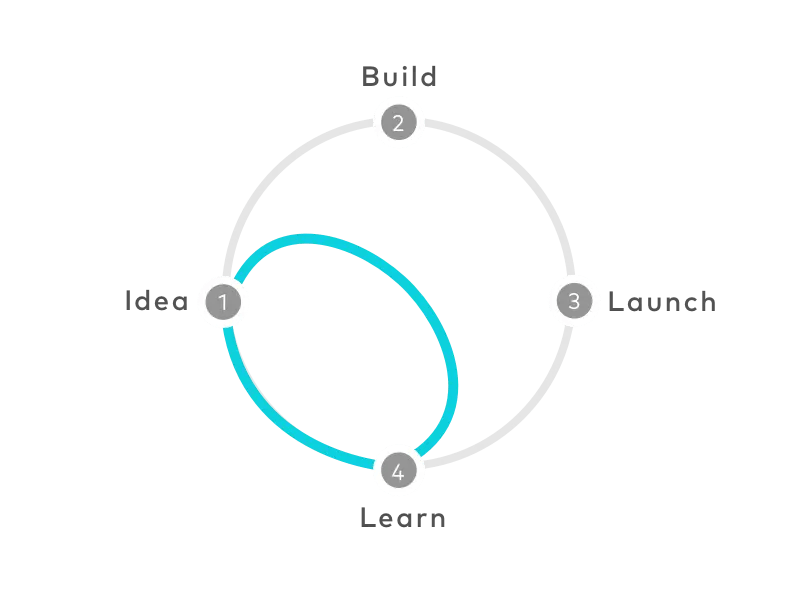
Design sprints offer a way for businesses to jump straight to the learning stage. Source: GV
Using a five-day cycle, teams can test product ideas and find areas for development. A standardized version of this five-day cycle could look like this:
- Day One: Envision a workable solution by mapping out the challenge and gathering subject matter experts. Pick an ambitious (but achievable) target to be met by Day Five.
- Day Two: Start to focus on solutions. Review existing ideas, then improve by chopping and changing. Sketch out potential solutions individually.
- Day Three: Review the individual solutions as a group and decide which have the best shot. As a group, turn the best solutions into a step-by-step plan for a prototype.
- Day Four: Act out the prototype plan, and develop a realistic stand-in for the end solution to test with customers, for example, a dummy software interface.
- Day Five: Finally, test the dummy prototype with customers. By learning from their reactions to the prototype, you have shortcutted the typical testing process.
The advantage of design sprints is speed and agility. Rather than having to develop full working solutions to problems, you and your team can instead jump straight to the finish and imagine what this potential solution would be like in practice.
Of course, this kind of exercise won’t be suitable for all industries or businesses. For example, a manufacturer of specialized medical equipment would likely get limited benefits from the process, as the technology underpinning each iteration of its product is too specific.
Despite this limitation, design sprints are still a very helpful method to have in your innovation toolbox. Used well, they allow a business to absorb all of the benefits of the customer testing process while expending only a fraction of the time and resources.
Innovation process #4: Business model innovation
In comparison with design sprints and lean innovation, innovating at the business model level involves thinking of new ways to deliver existing products to existing markets. This may sound counterintuitive, but the idea is quite simple: find better ways to deliver customer experiences.
Let’s start with a few basics: what is a business model, exactly?
According to innovation authors Karan Girotra and Serguei Netessine, a business model is a set of key decisions that collectively determine how a business earns its revenue, incurs its costs, and manages its risks.
Girotra and Netessine argue that the vast majority of businesses focus too much on innovation at the individual product or service level without asking fundamental questions about potential innovations to their business model.

Amazon’s grocery stores are a great example of a business model innovation. Source: Investors
As an example, this is like the manager of a chain of grocery stores thinking only about how he or she can secure the supply of popular products, rather than thinking about how to disrupt and improve the entire shopping experience for customers (like Hema or Amazon).
Business model innovations are changes to the key decisions underpinning how your company generates revenue. For example:
- What should your product or service offering be?
- How can this mix of products and services differentiate you from the competition?
- How should this offering drive revenue?
- When should business decisions be made?
- Who should make them?
- Why should these decision-makers have this responsibility?
Asking - and answering - these questions bravely and honestly can lead to some real breakthroughs for companies. For example, these kind of business model innovations can help to shake a company out of an unproductive status quo and find new revenue sources.
To help businesses consider innovations to their business model, Girotra and Netessine offer a helpful framework outlining a set of questions and prompts, including:
- Three ways for companies to recalibrate their product or service mix:
- Focus narrowly on one dependable product or service
- Search for commonalities across products
- Create a hedged portfolio of products to reduce risk
- Three strategies to improve the timing of company decisions:
- Postpone key decisions until information is available
- Change the order of your decisions
- Split key decisions for staged responses
- Three strategies to improve the quality of company decisions:
- Appoint a decision-maker who is better informed (possibly an external party)
- Pass decision risk to the party that can best manage the consequences
- Select the decision-maker with the most to gain
There are plenty of real-world examples of companies inventing entirely new markets by considering innovations to their business models:
- Uber: Rather than thinking about how to provide customers with a better taxi service, Uber looked for ways to sidestep the taxi model altogether, instead connecting drivers with a way to make money on their own.
- Netflix: Netflix started off focusing on the monthly mail delivery of DVDs, but soon realized the potential in giving customers the chance to stream content without having to sign up for cable channels.
- Amazon: No list of disruptive companies would be complete without Amazon. From the company’s humble beginnings delivering books to customer’s homes, Amazon chose to use its unparallelled logistics capabilities to offer anything and everything.
For more great tips on how to look for innovations to your company’s business model, check out Girotra and Netessine’s book The Risk-Driven Business Model: Four Questions that will Define Your Company.
Innovation process #5: Agile methodology
The Agile Method and methodology is a specific approach to innovation management focusing on delivering iterative innovations on a frequent basis. It also includes a focus on learning from the innovation process as it progresses and more information is gathered.
Agile shares some similarities with the design sprint process, as it also focuses on completing tasks in a compressed period of time, also known as a sprint.
Because of its use in managing unpredictable systems, Agile methodology is commonly used by teams in software development. It helps teams deliver functional improvements to products via timed phases, and includes a strong focus on collaboration.
The Agile methodology is an effective way to develop innovations once the early stages of design thinking have been completed. It is less effective as a tool to brainstorm and discover new areas of innovation, and more useful in turning potential solutions into reality.
There are two kinds of agile methodology relevant to the process of innovation:
- Agile Scrum
- Agile SAFe
We’ll now take a closer look at each of these.
Agile Scrum
Agile Scrum is an innovation process based on continuous learning and adjustment to new information and technology. As a process, Scrum can be tailored to the needs of any organization, though it focuses on the following three constants:
- A product backlog: This is a master list of required work maintained by the product owner or manager. Essentially, the product backlog offers a universal ‘to do’ list for innovation teams. It is under a constant process of revision and maintenance.
- A sprint backlog: This is a list of bug fixes or items selected by the process manager for attention and implementation in the current sprint cycle. Like the product backlog, the sprint backlog is flexible, though the overarching goal of the spring should not change.
- Usable end-product: At the end of the sprint, there must be a usable end-product, one which progresses the solution from its earlier stage to a more advanced one. For software teams, this would take the form of a new version of a software product.
Agile Scrum also involves assigning a few key roles, including:
- The Scrum product owner: The product owner is tasked with understanding the requirements of the business, market, and customer, and then making sure these are translated into priorities for the engineering team.
- The Scrum master: The SCRUM master is essentially the project manager for the SCRUM process, coaching teams, product developers, and the wider business on what to expect, and what is needed.
- The Scrum development team: Working at the direction of the product owner and the master, the development team puts vision into practice to produce a working product. They may have differing skill sets, including software development and customer design.
Agile SAFe
Similar to Agile Scrum, Scaled Agile Framework (also known as Agile SAFe) is a way of applying Agile practices in a way that is tailored to the needs and demands of particular enterprises.
Compared to Agile Scrum, Agile SAFe is a more streamlined process, though it still features a powerful number of tailored systems to help businesses deliver innovation projects.
In practice, Agile SAFe involves an innovation process like this:
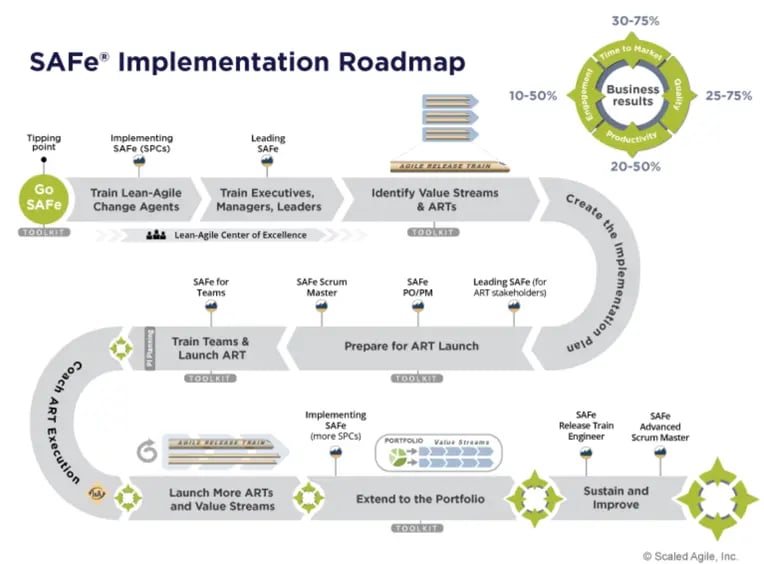
Agile SAFe involves a tailored process of development. Source: Scaled Agile
Innovation process #6: Growth & scaling
Finally, the last stop on our innovation tour is the growth and scaling process.
Growth and scaling are ways to work on expanding your product’s reach once you have a working solution, and on reviewing your performance to make sure you’re getting the most out of your innovations.
Naturally, these steps come after you’ve successfully arrived at a new innovation using a mixture of lean startup methods, design thinking, Agile methodologies, and more. By now, you’ve released something new into the market, and are tracking its performance.
At this stage in the process, a lot of companies take the pressure off and let the product find its market - or not.
As innovation writer Ash Maurya states, this is a big mistake: “You need not only the ability to visualize your customer lifecycle, but also the ability to measure it.” By focusing relentlessly on these measurements, he says, businesses can fine-tune their innovation performance.
Pirate metrics
In practice, the secret to measuring product performance to drive growth and scaling comes down to a strange-sounding term: pirate metrics, also known as AARRR.
Pirate metrics focus on the following five elements of measuring growth and scaling:
- Acquisition
- Activation
- Retention
- Referral
- Revenue
In practice, metrics based on these five elements can look like this:
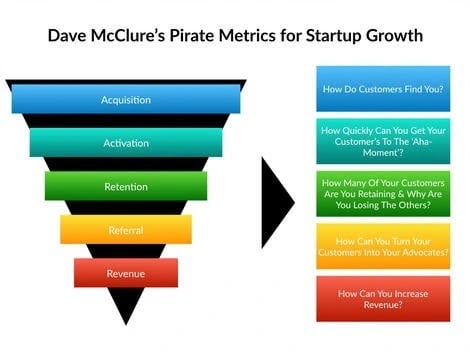
Pirate Metrics can really help you get the most out of your innovations. Source: Medium
By focusing on measuring these factors over time, you can audit your innovation process for effectiveness, and determine which of your innovation results matter the most to your business.
Committing to ongoing growth is a way to embed your innovation culture, and to ensure you’re getting the most out of your most valuable ideas. It’s also a way to make sure you get the best possible return on all that time and effort you and your team have put in at the outset.
How to avoid vanity metrics
Ongoing growth means setting the right KPIs and innovation metrics, using the right management tools to develop an overview of your innovation performance, and making bold decisions in accordance with this performance assessment.
Once again, here’s Ash Maurya with his thoughts on what makes a good growth and scaling metric. “An actionable metric is one that ties specific and repeatable actions to observed results.” For example, a breakdown of the means by which new customers find your product.
One thing to avoid when it comes to tracking growth? Vanity metrics.
“Vanity metrics like web hits or the number of downloads serve only to document the current state of the product,” says Maurya. “They offer no insight (by themselves) into how you got there or what to do next.”
So, be sure to track the most meaningful metrics available to you, and take the time to determine the most useful metrics to measure your growth and scaling.
Two other useful innovation models
In addition to these six processes, there are a couple of really useful innovation models you should know about. Whether you’re talking about process innovation, ideation, or blue-sky thinking, these two models can help you get the most out of your ideas.
Even better, these two models are useful at any stage of the process. They can help you clarify your thinking or refine your ideas no matter whether you’ve got only the first early sketches of an idea or a fully developed prototype.
Three Horizons innovation model
The Three Horizons model offers a simple way to think about the different timelines of sustaining, disruptive, and transformative innovation.
First articulated by Baghai, Coley, and White in their 2000 text Alchemy of Growth, the Three Horizons model approaches innovation along three distinct timelines:

The Three Horizons Model. Source: Medium
The Three Horizons model essentially creates stepping stones between managing innovations today and growing opportunities for the future. Used effectively, the model can help businesses maximize their current innovation capability and avoid being overtaken by competitors.
For any business, analyzing existing innovations according to this model is a helpful strategic tool, and helps complement the other methods and processes available.
Innovation Matrix
Developed by author Greg Satell, the Innovation Matrix is a fantastic tool to help businesses understand how best to approach an opportunity for innovation.
Greg Satell’s Innovation Matrix starts with two fundamental questions at the heart of every great innovation:
- How well can we define the problem?
- How well can we define the set of skill domain(s) needed to solve the problem?
Using these two questions, business leaders can then determine the right type of strategy needed to manage an innovation, and can draw from different sets of tools to solve the problem at hand.
This leads to the following four types of innovation:

Greg Satell’s Innovation Matrix is a useful tool. Source: HBR
As we can see, the Innovation Matrix breaks problems down into four types of innovation:
- Basic research, where both the problem and the necessary skill domains are both in need of clearer definition.
- Disruptive innovation, where the problem is not well defined, but the skill domains required to solve it are known in detail.
- Breakthrough innovation, where the problem is well defined, but the necessary skill domains require further definition.
- Sustaining innovation, where the problem and the skill domains needed to solve the problem are both well defined.
As with the Three Horizons model, the Innovation Matrix is an excellent tool to help companies approach a new area of innovation, and to allocate efforts and resources to the most promising areas of company innovation.
How to implement your own innovation process / program
As we’ve just pointed out, you can combine different innovation processes to build the right innovation process for your company.
Below, I’ll explain how you can define your own innovation process in 3 simple steps.
Step 1. Defining the process requirements
- Build a team. At Braineet, we saw that you need to establish a cross-functional & cross business task force with a strong leadership & executive sponsors. They will be in charge of defining the right innovation process.
- Process audit. You will need to find out what is working in your current product development methodology and what needs to be improved or fixed.
- Problem detection. Review past projects by conducting a post-mortem analysis.
- External & internal benchmarking. Books like Project Portfolio Management or Winner at New Products are absolute must-read.
Step 2. Designing the process
- Design the process. The team will need to define steps and associated goals, including validation steps with sponsors & expectations. And the different maturity levels to manage your project portfolio.
You should test multiple iterations of the process. Some companies shorten this step considerably by using a tool like Braineet Workflow. - Iteration with users & management. Your process needs to include feedback sessions, iterations with project leaders & senior management. You can start with a simple process and then refine it over time by gaining experience on current and past projects.
Step 3. Implementing the process
This final step is the most difficult and time consuming one. You need to get people to use the process in the organization, to support & live the process.
- Assign a process owner. This person will be responsible for the process and its evolution. He is accountable for establishing the process as defined.
- Training. You need to train people about the process, to explain goals & output. The process is unknown to everyone else in the company before they actually use it on a project.
- Bring projects into the process. Don’t wait for new projects, you can start injecting existing projects into the right step of the process.
- Documentation & support. You need to create a user-friendly documentation, and put in place a tool like Workflow to maximize user adoption. They will embrace the process quicker.
Examples of innovation processes in practice
Theory is all well and good, but the best way to understand the differences between these innovation processes is to look at how the world’s leading innovators use them.
Now, let’s finish our tour with a brief look at how IBM, Amazon, and Google innovate to give their customers and users more of the things they love most.
How IBM innovates
As one of the companies that has done the most to shape the modern computing world, IBM has a lot of valuable lessons to impart when it comes to innovation.
As author Greg Satell notes in Forbes, IBM has released a string of foundational innovations in software, computer memory, databases, and personal computers. Every time it has done so, argues Satell, it attracted a fresh new set of competitors, only to beat them out of the market.

IBM has been an innovation leader for decades. Source: Fortune
The key to IBM’s dominance? Using Agile innovation methods to drive the evolution of their products.
By using Agile methods, IBM employs a flexible, adaptive way to direct and motivate software development teams to complete important projects under demanding deadlines. Even better, Agile lets IBM organize its teams for self-sufficiency and maximum collaboration.
How Amazon innovates
Check pretty much any list of the world’s most innovative companies right now, and there’s one name that will pop up again and again: Amazon.
Far from the humble beginnings in the Bezos’ garage in 1994, Amazon has transformed into the most dominant logistics and delivery service in the world, and has even crossed the $1 trillion dollar valuation threshold.
So, how did Amazon do it? By focusing on relentless innovations to its business model.
Once again, author Greg Satell is on the case. As he notes, Amazon may have started out as a niche service selling books online, but it is now a dominant online retailer, and is pioneering new categories of products and services such as cloud computing and smart speakers.
What’s more, Amazon isn’t done yet. The company is constantly looking for ways to streamline its business model, and is always looking for new markets to step into.
How Google innovates
Last in the list is good old Google, master of the online search engine. In fact, Google has become so successful, the company’s name has even turned into a verb. You know you’re doing something right when you change the dictionary.
But how exactly did Google come to dominate over 92% of global web search traffic? By building a deep focus on growth and scaling in its innovation processes.
Google (now officially known as Alphabet) includes a tightly coupled feedback loop in its process of product release, making sure it has access to all the right data to understand the trends behind product uptake and success.
In the months and years following the release of a new Google product (for example, Gmail or Google Docs), Google researchers and product teams pore through the figures to identify any problems, areas for celebration, and opportunities for the future.
This not only helps the company evaluate where it got things right, but it also lets its product developers know how to improve things next time.
Conclusion: Know which innovation process is right for you
As we noted at the outset of our tour, one of the most important parts of innovation is knowing how to choose from the wide range of tools, methodologies, and processes out there.
The right approach to an innovation opportunity won’t just save you a lot of time and effort - it will also help you to emerge at the end of the process with the best possible solution to delight your customers, clients, and fans.
So, before you rush off and start filling up those whiteboards, take a second and think about how you could use the following innovation processes:
- Design thinking
- Lean startup model
- Design sprints
- Business model innovation
- Agile methodology
- Growth & scaling
And always take the time to research other companies who may have been through the same processes before. You never know what people might be willing to share!



